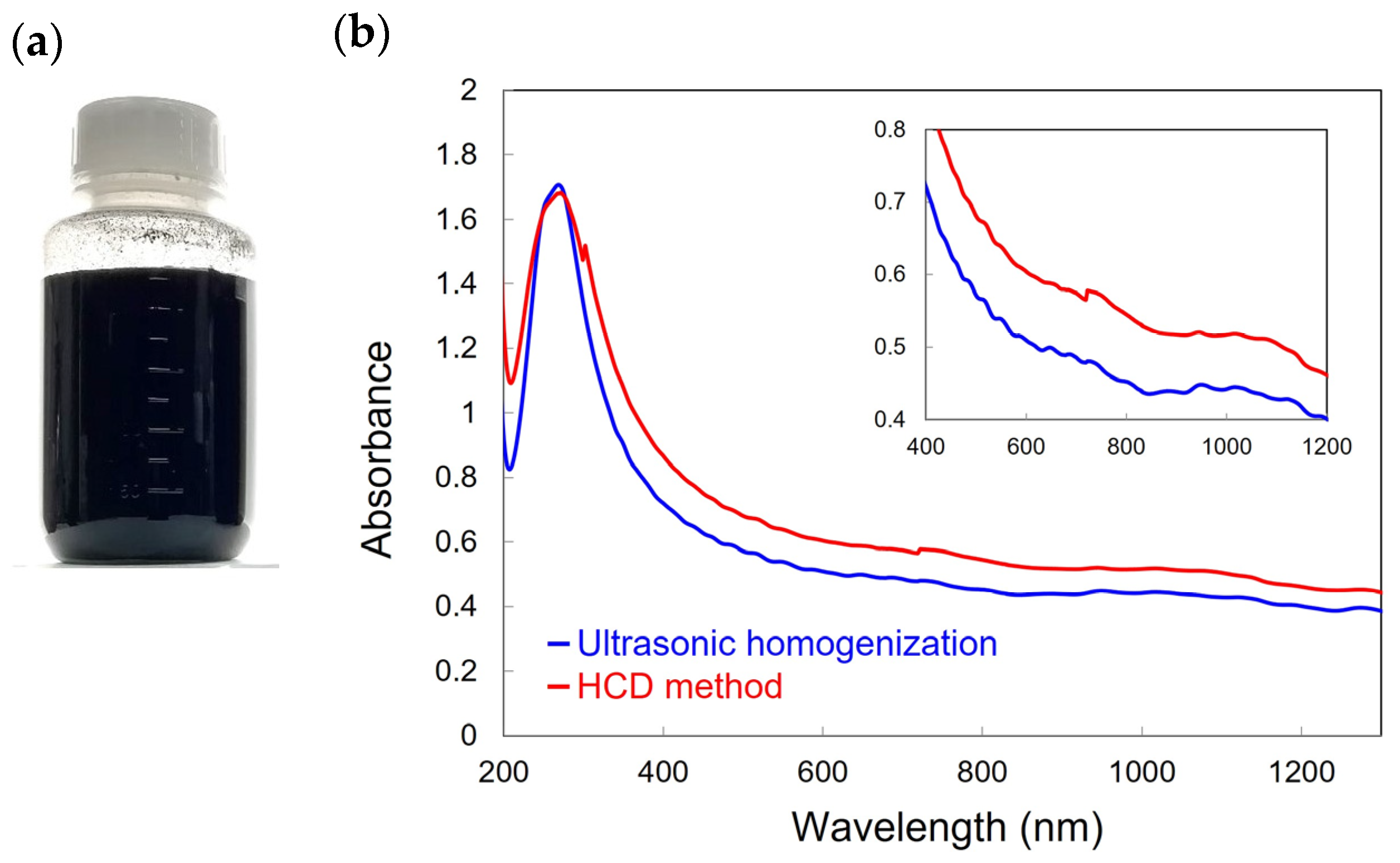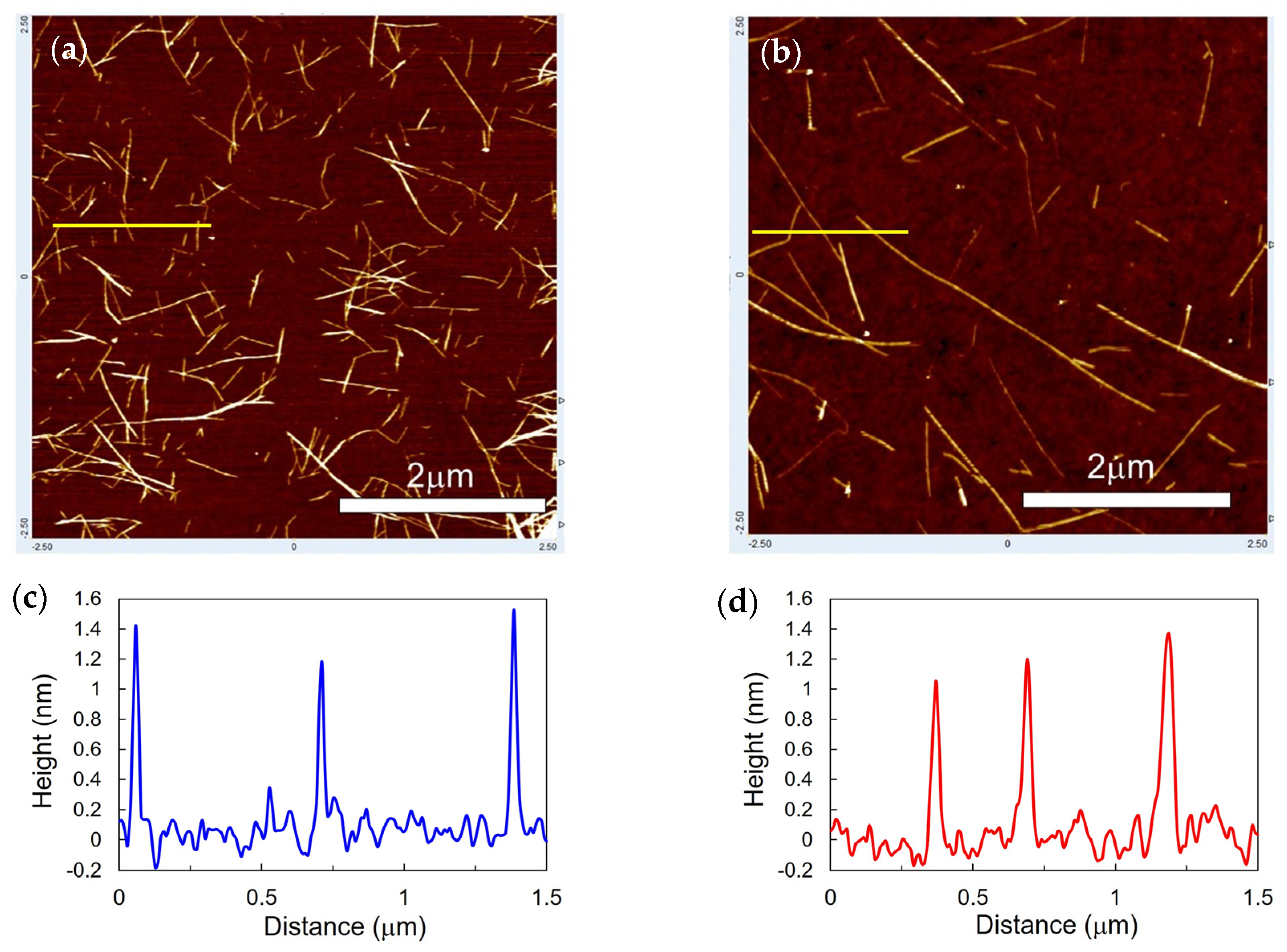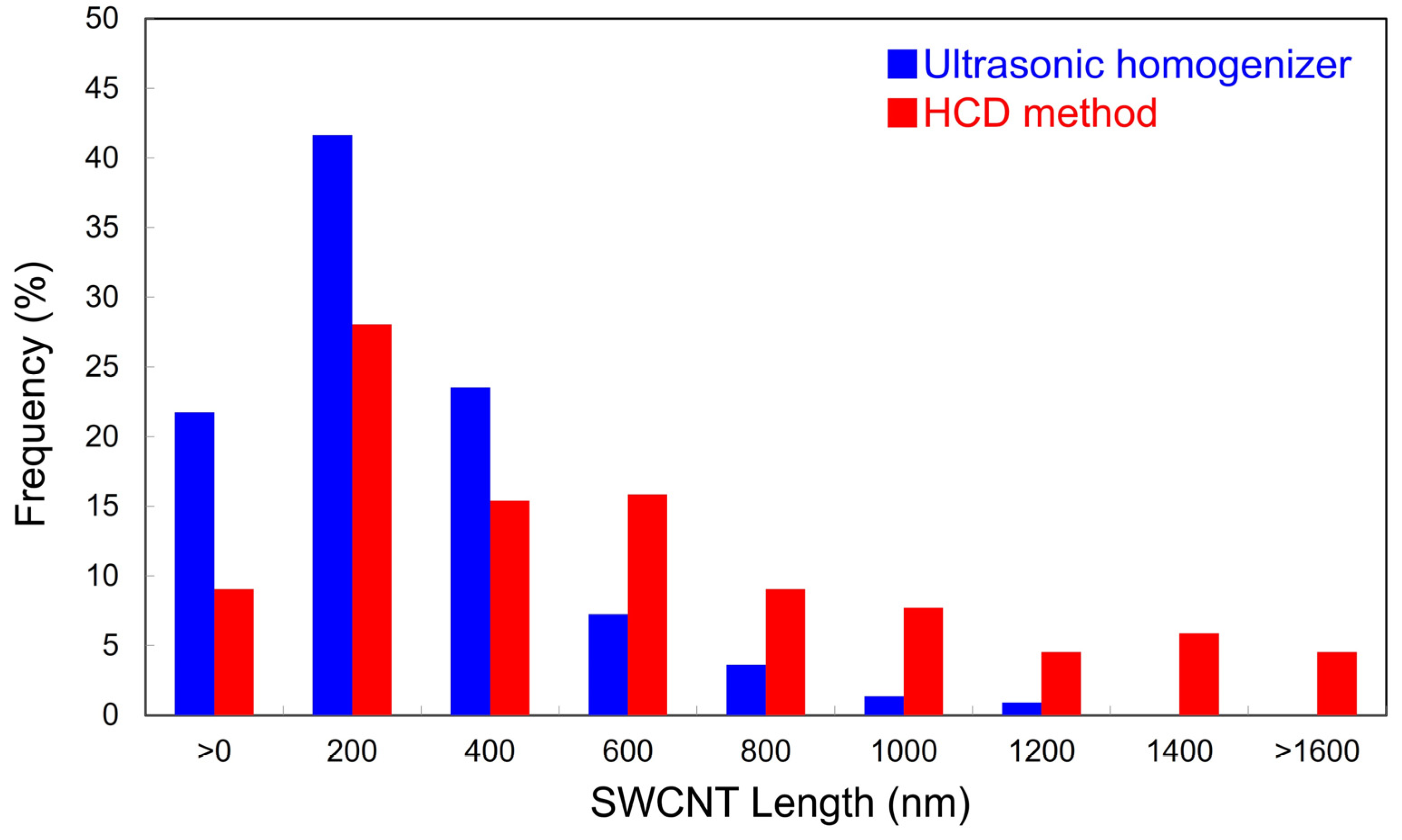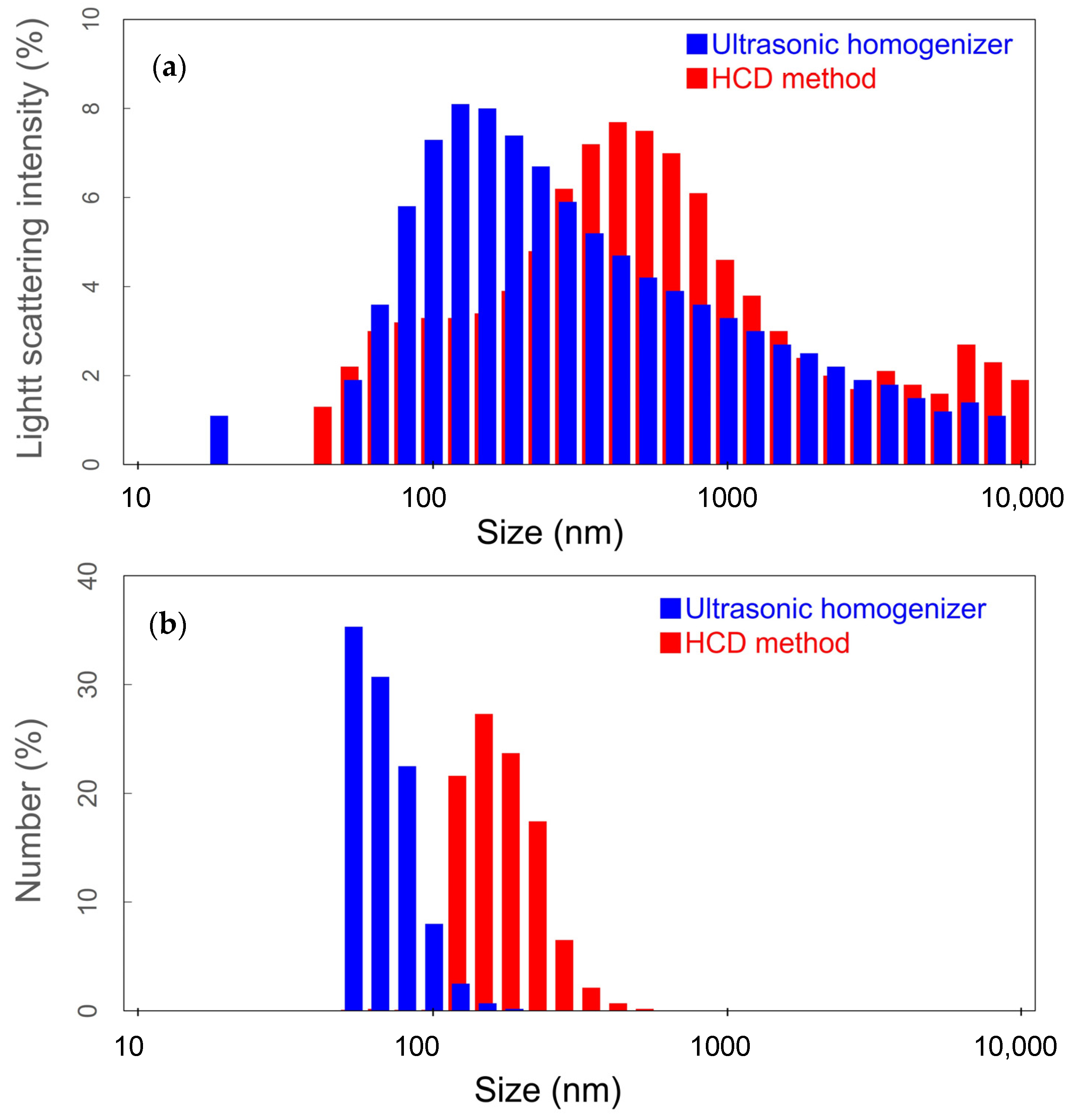Dispersion of Long and Isolated Single-Wall Carbon Nanotubes by Using a Hydrodynamic Cavitation Method
Abstract
1. Introduction
2. Materials and Methods
3. Results and Discussion
4. Conclusions
Author Contributions
Funding
Institutional Review Board Statement
Informed Consent Statement
Data Availability Statement
Acknowledgments
Conflicts of Interest
References
- Park, S.; Vosguerichian, M.; Bao, Z. A Review of Fabrication and Applications of Carbon Nanotube Film-Based Flexible Electronics. Nanoscale 2013, 5, 1727–1752. [Google Scholar] [CrossRef] [PubMed]
- Snow, E.S.; Novak, J.P.; Campbell, P.M.; Park, D. Random Networks of Carbon Nanotubes as an Electronic Material. Appl. Phys. Lett. 2003, 82, 2145–2147. [Google Scholar] [CrossRef]
- Fujii, S.; Tanaka, T.; Nishiyama, S.; Kataura, H. High Performance Thin-Film Transistors Using Moderately Aligned Semiconducting Single-Wall Carbon Nanotubes. Phys. Status Solidi B 2011, 248, 2692–2696. [Google Scholar] [CrossRef]
- Ohmori, S.; Ihara, K.; Nihey, F.; Kuwahara, Y.; Saito, T. Low Variability with High Performance in Thin-Film Transistors of Semiconducting Carbon Nanotubes Achieved by Shortening Tube Lengths. RSC Adv. 2012, 2, 12408–12412. [Google Scholar] [CrossRef]
- Kuwahara, Y.; Nihey, F.; Ohmori, S.; Saito, T. Length Dependent Performance of Single-Wall Carbon Nanotube Thin Film Transistors. Carbon 2015, 91, 370–377. [Google Scholar] [CrossRef]
- Hennrich, F.; Krupke, R.; Arnold, K.; Rojas Stütz, J.A.; Lebedkin, S.; Koch, T.; Schimmel, T.; Kappes, M.M. The Mechanism of Cavitation-Induced Scission of Single-Walled Carbon Nanotubes. J. Phys. Chem. B 2007, 111, 1932–1937. [Google Scholar] [CrossRef] [PubMed]
- Ramisetty, K.A.; Pandit, A.B.; Gogate, P.R. Novel Approach of Producing Oil in Water Emulsion Using Hydrodynamic Cavitation Reactor. Ind. Eng. Chem. Res. 2014, 53, 16508–16515. [Google Scholar] [CrossRef]
- Oka, Y.; Ohnishi, K.; Asami, K.; Suyama, M.; Nishimura, Y.; Hashimoto, T.; Yonezawa, K.; Nakamura, T.; Yatsuzuka, M. Dispersion of Carbon Nanotubes into Water without Dispersant Using Cavitation Bubble Plasma. Vacuum 2017, 136, 209–213. [Google Scholar] [CrossRef]
- Liu, L.; Shen, Z.; Yi, M.; Zhang, X.; Ma, S. A Green, Rapid and Size-Controlled Production of High-Quality Graphene Sheets by Hydrodynamic Forces. RSC Adv. 2014, 4, 36464–36470. [Google Scholar] [CrossRef]
- Yuan, H.; Liu, X.; Ma, L.; Gong, P.; Yang, Z.; Wang, H.; Wang, J.; Yang, S. High Efficiency Shear Exfoliation for Producing High-Quality, Few-Layered Mos2 Nanosheets in a Green Ethanol/Water System. RSC Adv. 2016, 6, 82763–82773. [Google Scholar] [CrossRef]
- Graf, A.; Zakharko, Y.; Schießl, S.P.; Backes, C.; Pfohl, M.; Flavel, B.S.; Zaumseil, J. Large Scale, Selective Dispersion of Long Single-Walled Carbon Nanotubes with High Photoluminescence Quantum Yield by Shear Force Mixing. Carbon 2016, 105, 593–599. [Google Scholar] [CrossRef]
- Shea, M.J.; Wang, J.; Flach, J.T.; Zanni, M.T.; Arnold, M.S. Less Severe Processing Improves Carbon Nanotube Photovoltaic Performance. APL Mater. 2018, 6, 056104. [Google Scholar] [CrossRef]
- Ran, B.; Katz, J. Pressure Fluctuations and Their Effect on Cavitation Inception within Water Jets. J. Fluid Mech. 1994, 262, 223–263. [Google Scholar] [CrossRef]
- Utomo, A.; Baker, M.; Pacek, A.W. The Effect of Stator Geometry on the Flow Pattern and Energy Dissipation Rate in a Rotor–Stator Mixer. Chem. Eng. Res. Des. 2009, 87, 533–542. [Google Scholar] [CrossRef]
- Gogate, P.R.; Pandit, A.B. Cavitation Generation and Usage without Ultrasound: Hydrodynamic Cavitation. In Theoretical and Experimental Sonochemistry Involving Inorganic Systems; Springer: Dordrecht, The Netherland, 2011; pp. 69–106. [Google Scholar]
- Saito, T.; Ohshima, S.; Okazaki, T.; Ohmori, S.; Yumura, M.; Iijima, S. Selective Diameter Control of Single-Walled Carbon Nanotubes in the Gas-Phase Synthesis. J. Nanosci. Nanotechnol. 2008, 8, 6153–6157. [Google Scholar] [CrossRef] [PubMed]
- Zhang, Y.; Cao, K.; Saito, T.; Kataura, H.; Kuzmany, H.; Pichler, T.; Kaiser, U.; Yang, G.; Shi, L. Carbon Nanotube-Dependent Synthesis of Armchair Graphene Nanoribbons. Nano Res. 2022, 15, 1709–1714. [Google Scholar] [CrossRef]
- Saito, T.; Ohmori, S.; Shukla, B.; Yumura, M.; Lijima, S. A Novel Method for Characterizing the Diameter of Single-Wall Carbon Nanotubes by Optical Absorption Spectra. Appl. Phys. Express 2009, 2, 095006. [Google Scholar] [CrossRef]
- Krause, B.; Mende, M.; Pötschke, P.; Petzold, G. Dispersability and Particle Size Distribution of Cnts in an Aqueous Surfactant Dispersion as a Function of Ultrasonic Treatment Time. Carbon 2010, 48, 2746–2754. [Google Scholar] [CrossRef]




| Dispersion Method | Average Length (μm) | Percentage of SWCNTs with Length >1 μm |
|---|---|---|
| Ultrasonic homogenization | 0.38 | 2% |
| HCD | 0.69 | 23% |
Disclaimer/Publisher’s Note: The statements, opinions and data contained in all publications are solely those of the individual author(s) and contributor(s) and not of MDPI and/or the editor(s). MDPI and/or the editor(s) disclaim responsibility for any injury to people or property resulting from any ideas, methods, instructions or products referred to in the content. |
© 2023 by the authors. Licensee MDPI, Basel, Switzerland. This article is an open access article distributed under the terms and conditions of the Creative Commons Attribution (CC BY) license (https://creativecommons.org/licenses/by/4.0/).
Share and Cite
Fujii, S.; Honda, S.-i.; Oka, Y.; Kuwahara, Y.; Saito, T. Dispersion of Long and Isolated Single-Wall Carbon Nanotubes by Using a Hydrodynamic Cavitation Method. Materials 2023, 16, 466. https://doi.org/10.3390/ma16020466
Fujii S, Honda S-i, Oka Y, Kuwahara Y, Saito T. Dispersion of Long and Isolated Single-Wall Carbon Nanotubes by Using a Hydrodynamic Cavitation Method. Materials. 2023; 16(2):466. https://doi.org/10.3390/ma16020466
Chicago/Turabian StyleFujii, Shunjiro, Shin-ichi Honda, Yoshihiro Oka, Yuki Kuwahara, and Takeshi Saito. 2023. "Dispersion of Long and Isolated Single-Wall Carbon Nanotubes by Using a Hydrodynamic Cavitation Method" Materials 16, no. 2: 466. https://doi.org/10.3390/ma16020466
APA StyleFujii, S., Honda, S.-i., Oka, Y., Kuwahara, Y., & Saito, T. (2023). Dispersion of Long and Isolated Single-Wall Carbon Nanotubes by Using a Hydrodynamic Cavitation Method. Materials, 16(2), 466. https://doi.org/10.3390/ma16020466







